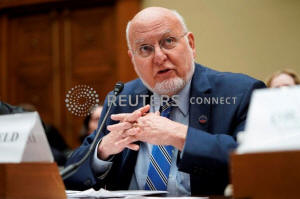CDC chief warns second COVID-19 wave may be worse, arriving with flu
season
 Send a link to a friend
Send a link to a friend
 [April 22, 2020]
(Reuters) - A second wave of the
coronavirus is expected to hit the United States next winter and could
strike much harder than the first because it would likely arrive at the
start of influenza season, the director of the Centers for Disease
Control and Prevention warned on Tuesday. [April 22, 2020]
(Reuters) - A second wave of the
coronavirus is expected to hit the United States next winter and could
strike much harder than the first because it would likely arrive at the
start of influenza season, the director of the Centers for Disease
Control and Prevention warned on Tuesday.
"There's a possibility that the assault of the virus on our nation next
winter will actually be even more difficult than the one we just went
through," CDC Director Robert Redfield told the Washington Post in an
interview.
As the current outbreak continues to taper off, as shown by a recent
decline in hospitalization rates and other indicators, authorities need
to prepare for a probable resurgence in the months ahead.
"We're going to have the flu epidemic and the coronavirus epidemic at
the same time," he said, and the combination would put even greater
strain on the nation's healthcare system than the first outbreak.

The virus, which causes a highly contagious and potentially fatal
respiratory illness dubbed COVID-19, emerged late last year in central
China. The first known U.S. infection, a travel-related case, was
diagnosed on Jan. 20 in Washington state near Seattle.
Since then, nearly 810,000 people have tested positive in the United
States, and more than 45,000 have died from the disease.
Redfield and other public health authorities credit drastic stay-at-home
orders and widespread business and school closings across the country
for slowing the spread of infections. But the restrictions have also
stifled American commerce while throwing at least 22 million people out
of work over the past four weeks.
Even as the lockdown is gradually eased, Redfield stressed the
importance of individuals continuing to practice social distancing among
one another.
[to top of second column]
|

Director of the Centers for Disease Control and Prevention (CDC) Dr.
Robert Redfield testifies about coronavirus preparedness and
response to the House Government Oversight and Reform Committee on
Capitol Hill in Washington, U.S., March 12, 2020. REUTERS/Joshua
Roberts/File Photo/File Photo

At the same time, he said, public health authorities must vastly
ramp up a testing system to identify those who are infected and to
locate their close personal interactions through contact tracing.
Asked about the recent flurry of street protests of stay-at-home
orders and calls for states to be "liberated" from such restrictions
- as President Donald Trump has advocated on Twitter - Redfield told
the Post: "It's not helpful."
Building a nationwide contact tracing network, key to preventing
newly diagnosed cases from growing into large outbreaks, poses a
major challenge because it is so labor intensive, requiring a
workforce that by some estimates would require as many as 300,000
personnel.
Redfield said the CDC is discussing with state officials the
possibility of enlisting and training workers from the U.S. Census
Bureau, and volunteers from Peace Corps and AmeriCorps, to create a
new contact tracing workforce.
(Reporting by Steve Gorman in Los Angeles; editing by Bill Tarrant
and Lincoln Feast.)
[© 2020 Thomson Reuters. All rights
reserved.] Copyright 2020 Reuters. All rights reserved. This material may not be published,
broadcast, rewritten or redistributed.
Thompson Reuters is solely responsible for this content.
 |